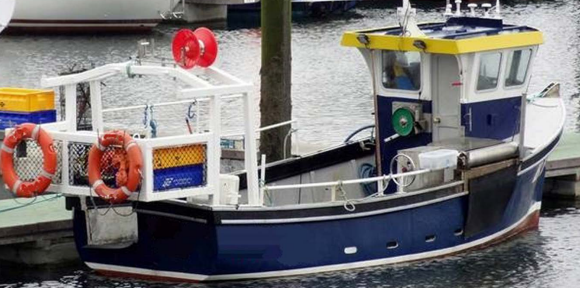The UK MAIB has reported an incident in which, early one winter morning, a skipper and his deckhand left harbour in their small potter and motored along the shoreline towards their creels. However, the boat developed a sudden list to port and then started sinking rapidly by the stern.
Both crewmen quickly scrambled onto the front of the boat’s cuddy as it turned vertical with the stern submerged. Neither of them was wearing a PFD and they had no time to collect one from the lifejacket stowage in the cuddy or make a “Mayday” call on the VHF radio.
However, the skipper was carrying a PLB and he was able to activate this before the boat sank. Both men managed to remove their oil skins and boots before they entered the water. The fishermen immediately felt the effects of the cold water, but managed to swim to a nearby marker buoy and cling onto it. The skipper, who was a strong swimmer, estimated that the shore was within reach and decided to try and swim there to get help. Before setting off he gave the PLB to his crewman. The distress signal from the PLB had been received by the coastguard ashore and the location of the crewman was quickly established. In response, the coastguard tasked four local lifeboats, a coast rescue team and a helicopter to search the area. In the meantime, the crew of another small fishing boat that was working in the area saw what they considered to be an unusual object in the water, and decided to investigate. As the boat approached, its crew quickly realised that the object was in fact a very cold and distressed fisherman desperately clinging onto a marking buoy.
Having been recovered from the water, the distressed crewman told his rescuers that his skipper had attempted to swim for the shore. The fishing boat’s skipper alerted the coastguard to the situation by VHF radio before landing the casualty ashore. Having transferred the casualty to a waiting ambulance the fishing boat returned to sea and joined the search for the missing skipper. Fortunately, the skipper had managed to reach the shore but, without any means of raising the alarm, he had taken shelter in a disused lighthouse. When he was eventually found by the crew of one of the lifeboats that was searching for him, he was perilously cold and was subsequently airlifted to hospital. Both men were treated for hypothermia and released from hospital soon after the accident.
Lessons Learned
1. Both fishermen were extremely fortunate not to have drowned after entering the water; the skipper only just made it ashore and the crewman holding onto the buoy was close to giving up. The potter was equipped with three PFDs, two of which were compact, auto-inflation lifejackets specifically designed for use while working on deck. Had they been worn, the lifejackets would have provided the crew with vital additional buoyancy as they waited for help in the cold water.
2. This case clearly demonstrates the need to expect the unexpected and to be properly prepared for every eventuality. This means always wearing a PFD when working on deck at sea; no matter how accessible the lifejacket might appear, there simply might not be time to grab one in an emergency.
3. Carrying a PLB could save your life. The activation of one will alert the coastguard to a distress situation, identify the casualty and provide a location. The PLB carried by the skipper in this case had not been registered and therefore the amount of information available to the coastguard was limited. It is vital that electronic safety beacons, such as PLBs, are registered with the coastguard as this will ensure that the emergency service has quick and easy access to crucial information and key points of contact. This is very important as the coastguard can contact family and friends to establish how many people are on board, working routines etc.
Source & Image credit: UK MAIB Safety Digest 2/2016






























































